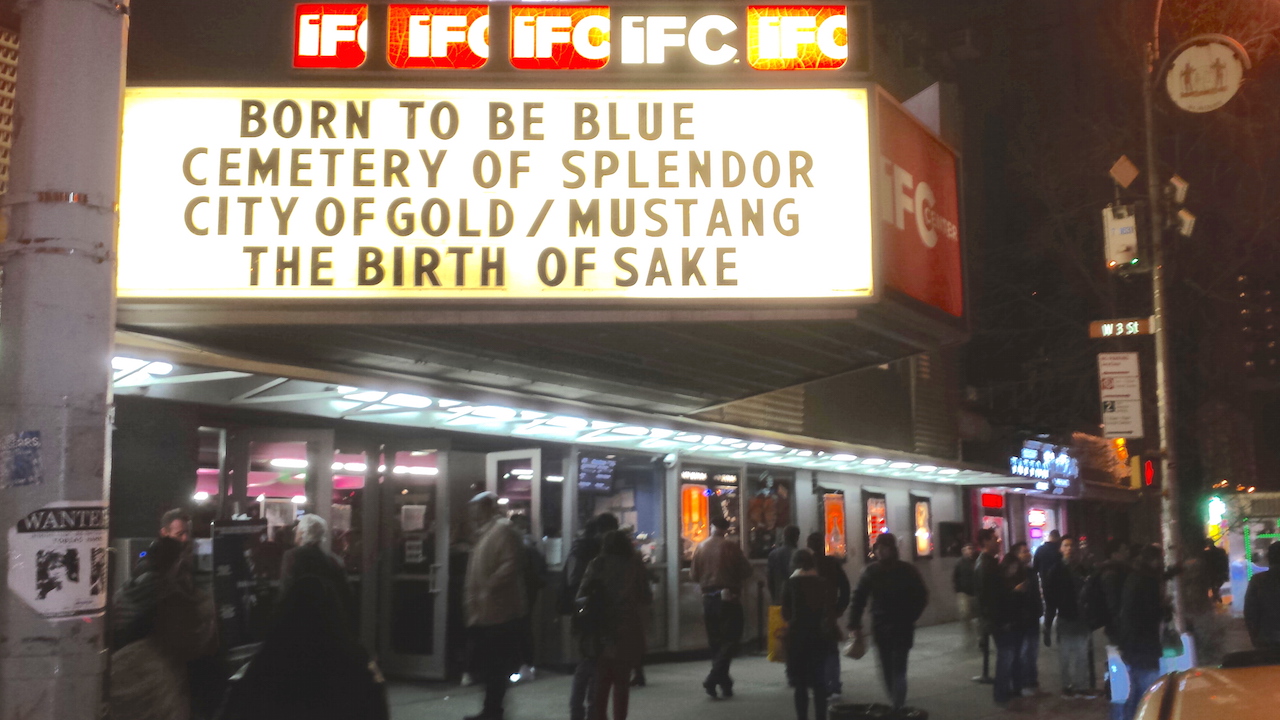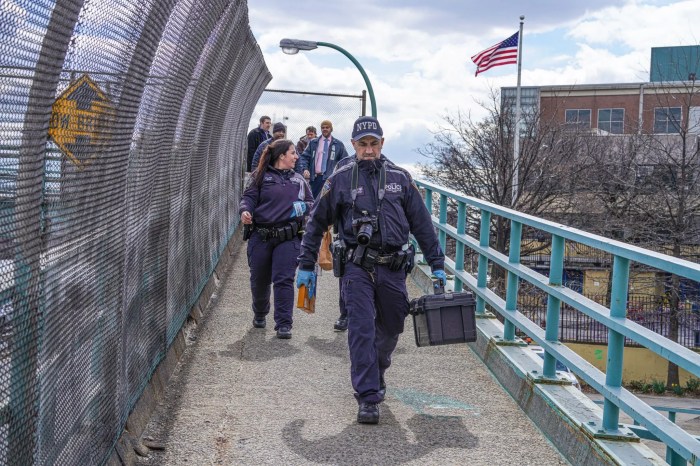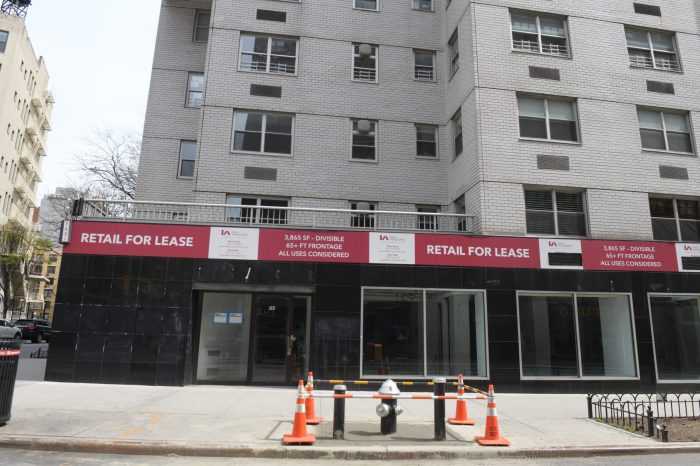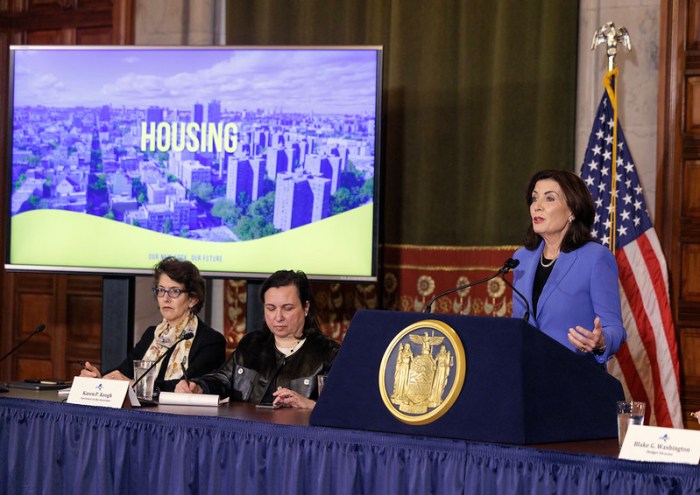
BY LINCOLN ANDERSON | Cut! Don’t roll it!
Villagers are having mega-fears that a Times Square-style movie megaplex will materialize at the site of the current IFC Center, if the property owner’s plans are approved by the city’s Board of Standards and Appeals.
On March 18, Friedland Properties, the owner of the indy moviehouse, at Sixth Ave. and W. Third St., applied to the B.S.A. for a variance to allow eight changes, among them increasing the theater’s current number of seats from 480 to 948, plus adding two more stories aboveground and a cellar level, as well as converting an empty residential lot into an indoor waiting area and space for more seats.
The existing IFC Center has five theaters ranging in size from 35 seats to 210 seats. The building was originally constructed as a church in 1853. After an interim period as a factory, in 1938 it opened as a movie theater and has operated that way since.
“However, the limited size and footprint of this 160-year-old building imposes significant restrictions in terms of theater layout and operation,” the application states. “The footprint…is also extremely inefficient in terms of patron circulation.”
The proposed expansion would create “an optimum size and layout to present a varied film product,” the application contends.
The current cinema lacks sufficient space for indoor queueing, forcing moviegoers to line up on the sidewalk outside, the owner notes. Under the proposal, part of the property — a residentially zoned open lot on Cornelia St. behind the theater — would be rezoned to allow commercial use, and would be developed, on the ground floor, as an 1,865-square-foot indoor waiting area for ticket holders. This rezoned section of the property would also have more than 200 theater seats.
The scheme would see the Cornelia lot sport a five-story windowless brick wall. Movie patrons would continue to enter and exit the theater on Sixth Ave.
The Cornelia St. part of the property is landmarked as part of the Greenwich Village Extension II Historic District. However, in November, the city’s Landmarks Preservation Commission issued a certificate of appropriateness for the design plan for the Cornelia lot, saying, “the proposed building will fill a gap which currently disrupts the continuity of the street wall.”
To win B.S.A. approval for the changes, Friedland must prove financial hardship.
The IFC did, though, have a smash hit in 2011 with Werner Herzog’s 3-D documentary on historic cave paintings, “Cave of Forgotten Dreams.” With nearly $700,000 in ticket sales, the film generated more box office from one screen at IFC than any other film generated on a single screen in America in the past decade.
However, neighbors say the proposed expansion is way too big, and that there are too many unanswered questions. They have formed an ad hoc group, Friends of Cornelia St. Coalition, and hired top attorney Stu Klein to represent them. On Monday night, they held a fundraiser at Palma restaurant on Cornelia St.
“They need to show hardship,” said David Gruber, head of the Carmine St. Block Association, part of the coalition. “We think it’s a real estate scam. Friedland also owns a lot of property on Eighth St.
“Our fear is it will become a big Trojan horse, especially if we give them 1,000 seats, up from 500 seats,” he added. “They could have gone to City Planning for a waiver. Instead they took it over to B.S.A., which has enormous power.
“If you can’t fill 480 seats, how does 1,000 seats make it easier?” Gruber asked. “They portray themselves to be a neighborhood art house, and here they are building something that’s so different from everything else,” he said of IFC.
“Something doesn’t feel right in this whole thing,” Gruber said, “like we’re being taken for saps.”
Musician Leif Arntzen of Cornelia St., another leading member of the new group, said a serious concern is that, if the property gets expanded, it could then get turned into a retail use.
“If you look at the drawings, they go down a full floor,” he noted of the plans. “The lobby is designed to go all the way from Sixth Ave. to Cornelia St. You’ve got a street-to-street, enormous retail space. You’ve got five floors.”
Gruber said one negative scenario would be if the IFC became a 2,000-to-3,000-square-foot restaurant, for example. He added that another concern is the length of IFC’s lease.
“If they have a short lease, what are we doing?” he asked of the expansion plan.
Perhaps the biggest fear of all is that IFC’s parent company is AMC Networks, which conjures up nightmare visions of the massive AMC theater on 42nd St. But Gruber and Arntzen both said they were a bit unclear about what exactly fell under the umbrella of AMC Networks. It may well not be AMC Theatres, they admitted — yet the mere name AMC is enough to give them horror movie-like chills.
Gruber conceded, “We could be off on all of this. Maybe they need 1,000 seats. Maybe they need to expand. They may get what they want — but we’re gonna get some answers.”
For starters, John Vanco, the Village theater’s senior vice president and general manager, gave some answers in response to The Villager’s questions. Asked if, with the expansion, IFC’s programming would feature more blockbuster-style pictures, he said no.
“Independent films are at the core of IFC Center — they’re in our DNA,” he said. “In our 10-plus-year history, we haven’t opened a single Hollywood studio picture, and we have no plans to alter that policy. We bring smart, engaged audiences a wide range of independent and foreign films, classics and documentaries, and we’ll keep on doing just that. Cinemas in the Village have always championed new voices in independent cinema, and we’re very proud to share that history and responsibility. Both our current design and the plans for the expansion explicitly reflect the needs of our public and of the independent film community — intimately sized theaters offering the great variety of cinema that New Yorkers demand.
“Second,” Vanco stressed, “please note that the IFC Center’s parent company is AMC Networks — which is dedicated to producing quality original television programming, and owns and operates several award-winning brands in cable television, including AMC, IFC, SundanceTV and WE tv. The IFC Center and AMC Networks are not related in any way to AMC Theatres. The IFC Center is the only cinema owned or connected to AMC Networks.”
Asked how doubling the number of seats would help the place turn a profit, Vanco said the problem actually isn’t filling seats — but rather that the theater cannot currently accommodate everyone who wants to see flicks there.
“IFC Center’s diverse programming draws consistently large crowds who are clamoring for more great cinema,” he said. “The greater number of theaters and the large new lobby — nearly 10 times as big as our current lobby — will allow our patrons a much better experience while waiting to attend a broader offering of films, with fewer people turned away from sold-out shows.”
Asked what exactly IFC Center’s financial hardship is, he said, in fact, it’s a “textbook example.”
“Zoning variances are intended to alleviate the ‘financial hardship’ for properties that cannot generate a reasonable return on their value because they are burdened by unique physical conditions,” he explained.
“The IFC Center property is a textbook example of this kind of site. Its shape is highly, and singularly, irregular; it is divided by a zoning district boundary; and it is occupied in part by a 160-year old building in a historic district that has been used as a theater since 1937. Moreover, the existing building is sited in a way that precludes obtaining a positive return from development of the vacant portion of the property in accordance with the applicable zoning controls. The requested variance would relieve IFC of the burden of carrying this partially developed property and allow it to utilize its entire site in a way that produces the ‘reasonable return’ that is the goal of the variance process.”
Asked how long the IFC Center has left on its lease, Vanco said they hope to stay there for the long run.
“We are in the middle of a long-term lease with our landlord and the fixed costs represented by the vacant portion of our lot are a major concern,” he answered. “There is significant demand for the film programs that IFC Center presents, and this expansion project is crucial in order for us to continue our commitment to be the West Village’s neighborhood art-house theater for decades to come.”
Asked if the expanded theater, in fact, could be swiftly transformed into a retail space, Vanco said such a bait-and-switch is not IFC’s plan at all.
“The B.S.A. variance is exclusive to this specific use — the property must be used in accordance with the approved plans,” he said. “Any change to the approved plans would require a new public process. Further, the IFC Center is investing millions of dollars to create a facility that specifically serves the needs of the independent film constituency, a facility we believe will be the finest independent film center in the nation. Our investment speaks to our commitment to this use, to our very existence.”
The application will be considered by the Community Board 2 Land Use and Business Development Committee at its Wed., April 13, meeting at 6:30 p.m., at the Scholastic Building, 557 Broadway, 11th floor conference room.

















